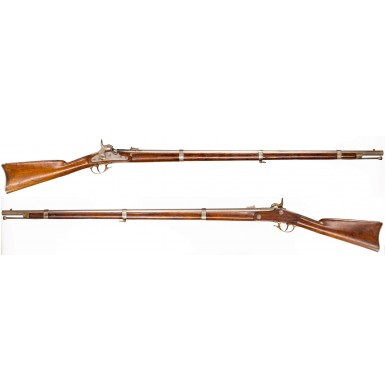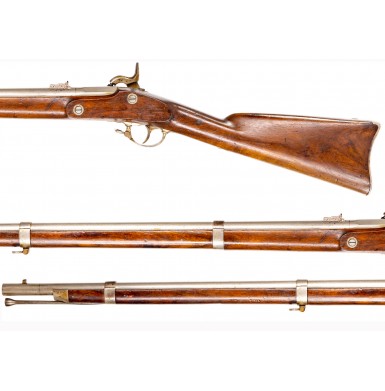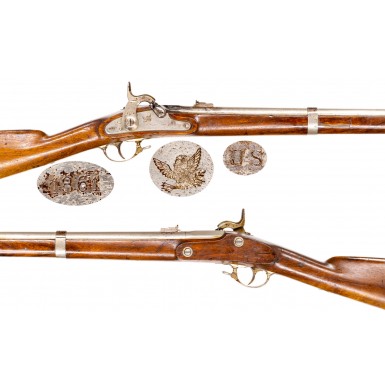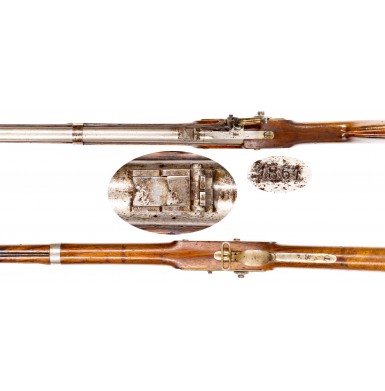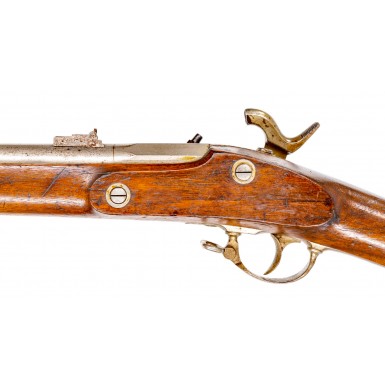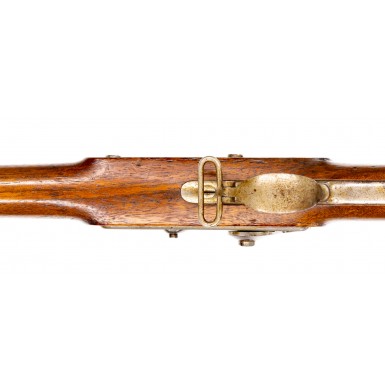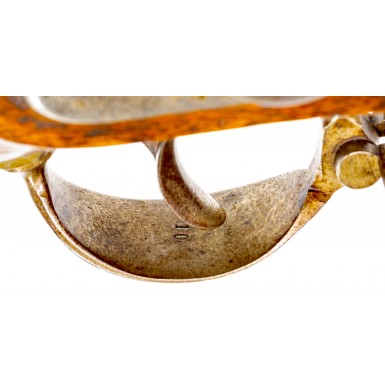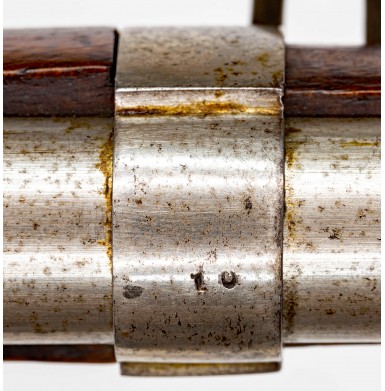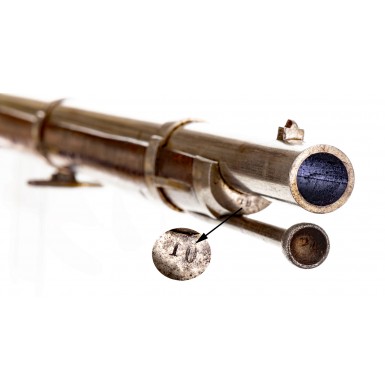Extremely Scarce and Fine Suhl 1861 Springfield Rifle Musket by Christian Funk
- Product Code: FLA-R126-SOLD
- Availability: Out Of Stock
-
$8,750.00
Of all the imported arms utilized by the US government during the American Civil War, the SUHL Contract Model 1861 Rifle Musket is probably one of the most desirable and most difficult to obtain for a collection. In fact, the authors of Firearms from Europe (2nd Edition) describe the gun as “one of the rarest of all Civil War weapons” and further note that “only a handful are known to exist”.
The details regarding these handmade Germanic copies of the US Model 1861 Rifle Musket are not particularly clear, but it appears that most of the guns were probably produced by Christian Funk of Suhl, which was located in the German state of Thuringia. The guns were most likely imported by William Hahn of New York. According to US Ordnance Document records, Hahn delivered 481 “German Muskets, Springfield Pattern”, at prices that ranged from $14.50 to $16.50 each. The deliveries were made in two lots, with 179 being delivered 7 March 1862 and the balance of 302 being delivered on July 15 of the same year. Schuyler, Hartley & Graham of New York delivered an additional 400 “Suhl Rifles” and “Suhl Rifle-Muskets” to the US Government between February 17 and March 10 of 1862. However, the pattern of these arms is not noted in the delivery documents. The majority of the rifle-muskets of Germanic origin that were delivered by Schuyler, Hartley & Graham were of the Enfield pattern, making it likely that these 400 guns of “unspecified pattern” were also of the Enfield pattern that was also produced in Suhl, and not Model 1861 types.
The Suhl “Springfield” was essentially a handmade copy of the US Model 1861 Rifle Musket. It was a .58 caliber muzzleloading rifled musket with a 40” round barrel. The breech area of the musket had a pronounced octagonal section; making is somewhat bulkier in that area than the standard US muskets. As the guns were handmade, they did not feature interchangeable parts. This meant that the US Ordnance Department considered them to be “2nd Class” arms, even though they were of the standard .58 caliber. The extant surviving examples of these rare guns are known with various markings, but the two consistent features on all known examples are the unique variant of the American “Spread Winged Eagle” on the lock plate and the assembly numbering of the component parts of the gun. This assembly numbering varies in location and style between known examples. Some show the numbers on every single part, down to the necks of the screws, and some show less consistent numbering, with some variation as to exactly where the assembly numbers are applied. The fact that these numbers are actually assembly or batch numbers is proved by the fact that the numbers encountered are always rather low. The numbers are typically under 50 to my knowledge. The fact that I have personally examined two different Suhl M1861s that were both numbered “19” further indicates that they are assembly, rather than serial numbers. In examining three fine condition examples over the last couple of years I have had the opportunity to fully disassemble the guns, including the removal of the 1858 pattern rear sights. I did this to confirm that that sights were assembly numbered to the guns. What I found was quite interesting. The gun that was assembly numbered “20” over its entirety was numbered “31” under the sight base and in the rear sight dovetail. The fact that the barrel, which was numbered “20” on its bottom, matching the other assembly numbers, was numbered “31” in the dovetail, as was the sight, suggested that maybe this was more of a serial number than an assembly or batch number. This was supported when I disassembled number “19” (the second gun I had seen with that number) and found that it was numbered “152” under the rear sight and in the dovetail. Finally, the gun offered here, which is assembly numbered “10” throughout has the serial number “32” under the sight and in the sight mortise. These three examples prove almost conclusively that these secondary number markings relate the number of guns produced, rather than being a secondary assembly number.
Some of the known examples are marked CH. FUNK / SUHL on their locks, while some bear no maker’s mark at all. In some cases, this same mark is found on the interior of the lock plate and/or on the bottom of the barrels. At least two styles of “US” markings on the lock are known, and proof marks vary among the handful of known specimens, with some marked externally and some marked under the barrel. All known examples are dated 1861, with the exception of one that is dated 1862. The guns are marked with these dates on the tail of the lock plate and usually on the top flat of the breech. Some are known with US inspectors’ cartouches on the stock flat, and some are known with no such marks. At least one example is known with an “OHIO” stamp, but that would have been applied by the state of Ohio when it received several lots of surplus and second-class arms from the US Government in 1863-64 to recompense the state for arms it had provided to its volunteer troops at the beginning of the war.
Some authors have referred to the guns as having stocks made of “maple” or “light colored European walnut”. From my observations of a handful of extant examples, the guns appear to be stocked in beech, which would have been the typical stock wood used in Prussian arms of the period. It is possible, however, that a contract to produce US pattern arms would have specified the type of wood to be used in the stocks, so some may have been stocked in a light-colored European variant of walnut.
One interesting fact rarely noted is that most of the finer condition examples known to exist retain at least some remnants of tin plating. When I first encountered this a few years ago I had assumed the plating was a post war addition, possibly from display in a Grand Army of the Republic (G.A.R.) Hall collection. Since then, I have examined some other examples that show the exact same finish, suggesting that the guns, or at least a portion of them, may well have been delivered tinned.
The Suhl Contract US Model 1861 Rifle Musket offered for sale here is in about VERY FINE condition. The gun appears to be 100% complete and correct in every way, with nearly every part marked with the assembly number 10. In some cases, the marks are weak or difficult to see, and in others the oddness of European style “1” die used made a weakly struck mark that initially appears to be a different number. The external markings remain extremely crisp, and sharp throughout, with only some of the assembly numbers showing any particular wear or weakness. The internal markings remain quite crisp as well. The metal remains in wonderful condition and shows much of the thin period tin plating. The plating has flaked and worn, particularly around the breech and bolster area, but retains at least 85%-90% of that original tin-plated finish. The areas where the plating has flaked and worn have developed a moderately oxidized, brown patina. The metal also shows some minor staining from some old, dried grease or oil that has left brownish patches scattered on the metal, which can sometimes be difficult to separate from the flecks of surface oxidation. The metal is almost entirely smooth, with only some very lightly scattered areas of light pinpricking, again mostly around the breech and bolster area. The tin-plated finish has preserved the metal very well. There is also scattered surface oxidation that has left discolored freckles of darker gray and some brownish color over much of the gun’s metal. The lock is mechanically excellent and functions crisply and correctly on all positions, with the hammer responding to the trigger exactly as it should. All of the primary interior lock parts are stamped with the matching assembly number 10. The interior of the lock is also stamped, above the mainspring, CH. FUNK / SUHL. In a departure from the US Model 1861 lock design, but typical of European percussion muskets, the half-cock notch is just barely above the cone (nipple), allowing the hammer to act as a cap safety to keep it in place. While a US musket can be (and was supposed to be) capped at half cock, these guns would require the hammer be pulled to full cock for capping, and then lowered to the half cock position where it would be so close to the cone that the cap could not fall off. The exterior of the lock is clearly marked with the date 1861horizontally to the rear of the hammer, and with the unique {Spread Winged Eagle} forward of the hammer in the upper center portion of the lock, behind the bolster. The front edge of the lock is marked U S, with the same style mark applied to the buttplate tang. The top of the breech flat is clearly marked with a matching 1861 date as well. There are no other external marks on the barrel other than the date on the breech. The bottom of the barrel is marked with the same CH. FUNK / SUHL mark found inside the lock, and with a variety of foreign assembly and proof marks. The bottom of the barrel is also marked SUHL and 10. This same assembly number is present inside the lock as noted, on the inside neck of the hammer, on the bottom of the buttplate, inside the trigger guard, on the necks of the screws, on the tops of the barrel bands and the face of the nose cap. I have seen examples where even the ramrod was numbered. While this appears to be an absolutely correct, original Suhl contract rod (the tulip heads are not quite the same as the US rods, being somewhat more geometric and less smoothly rounded), I could not find a number, but it could have been worn off or poorly struck as well. Like a US Model 1861 Rifle Musket, the barrel bands are all marked with a “U” for “up”. The bore of the musket is in about FINE condition with deep, crisp rifling along its entire length. The bore shows some scattered peppering and some minor light pitting scattered along its length. The gun retains its original and correct multi-leaf rear sight, which is copied from the US Model 1858 pattern sight. This indicates that the pattern gun that Funk used to produce these rifle muskets was produced prior to July of 1861, when the Ordnance Department adopted the new Model 1861 pattern rear sight, designed by Elisha K. Root of Colt’s Patent Firearms. The sight base even includes the “steady pin” and the barrel has a “steady pin notch”, features that were standard on US Model 1855 Rifle Muskets from 1858-1861; a feature that was quickly phased out on the Model 1861 after July of 1861 and that only appears on the earliest production examples of those rifle muskets. The gun also retains both original sling swivels. The rod is full-length and retains the original threads at the end. The stock rates about VERY FINE as well and is solid without any breaks or repairs. The stock is extremely crisp with very sharp edges and lines throughout, showing no indication of having ever been sanded. The wood even retains some traces of feathery texture. There are no visible cartouches on the musket stock, and it does not appear to have ever been so marked. The stock shows the usual scattered assortment of bumps, dings, and other handling marks from use in the field but shows no real abuse. Even the ramrod channel remains crisp and sharp showing only some very minor chipping. The stock has a light brown color with a slightly orange tone (really almost honey colored), which is reminiscent of the Germanic beech wood found in Potsdam and Lorenz musket stocks. The wood to metal is very fine throughout, every bit as good as the fit and finish found on many US contractor made guns of the period.
Overall, this is an extremely high condition example of an incredibly scarce US imported rifle musket. It is unlikely that more than a few hundred of these German made Model 1861 rifle muskets were purchased during the course of the war. There are truly only a handful of these guns known today, with most of them in museum collections. These guns practically never come to market for sale, and for the advanced collector of unique, imported Civil War martial arms, a Suhl Model 1861 is truly a “Holy Grail” acquisition. This is a great opportunity to own a really fantastic condition and wonderful displaying example of one of the absolute scarcest of US imported arms to be used during the American Civil War. It may be years before another one is available, and this is only the sixth example that I have had the opportunity to offer over the past twenty years.
SOLD
Tags: Extremely, Scarce, and, Fine, Suhl, 1861, Springfield, Rifle, Musket, by, Christian Funk


